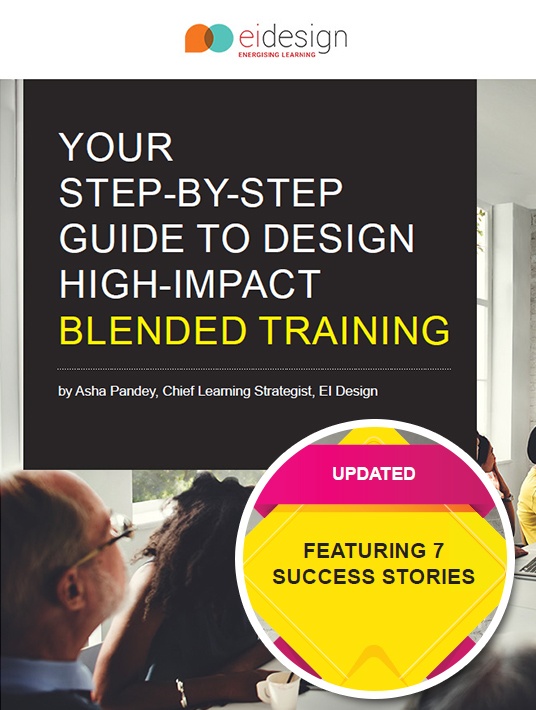Your Step-by-Step Guide To Design High-Impact Blended Training – Featuring 7 Success Stories [2018 Update]
In Oct’17, I released the eBook Your Step-by-Step Guide to Design High-Impact Blended Training Programs (you can read about it in this article).
In Mar’18, I did a webinar on the same subject and have used the pointers to update the eBook.

The notable changes in the updated release of Your Step-By-Step Guide To Design High-Impact Blended Training Programs - Featuring 7 Success Stories are:
- The inclusion of top 5 challenges associated with the transformation of ILT to blended training.
- How can these challenges be offset through our step-by-step toolkit that can guide you through a successful transition?
- 7 success stories that outline how high impact blended training were created.
The updated eBook provides several insights including:
- The definition and the factors that are increasing its adoption.
- The benefits that organizations and learners will see as ILT programs transition to blended training.
- The key challenges that you may face as you transition from ILT to blended training.
- A step-by-step guide that you can use to offset these challenges.
- Tips and best practices that can help you transition to blended training effectively.
- 7 examples that show you success stories of effective transition from ILT to blended training programs. The featured examples include instances of 5 corporate training needs and two examples from higher education segment.
While there are several reasons why organizations are looking at moving their ILT training programs to blended training; the top 3 reasons are:
- Business need to train a wider audience in a shorter time.
- Training budget cuts or need to use the available budgets optimally.
- Learners are seeking higher flexibility in the way they want to learn (on the go, self-paced, and on the device of their choice).
This is also reaffirmed by a research:
According to the 2016 Benchmark Report: The State of Online Training, ‘Technology has not decreased the demand for Instructor-Led Training but gives instructors new tools to reach learners…The trend in Instructor-Led Learning is enablement through technology, both in hybrid and fully virtual delivery.’
How Will This eBook Help You?
The transition from ILT to blended training offers several advantages. However, it also has several associated challenges too.
In Your Step-By-Step Guide To Design High-Impact Blended Training Programs - Featuring 7 Success Stories, I introduce our step-by-step toolkit that you can use to handle the challenges and create a successful transformation of your existing ILT to blended training.
This is not all. I also list out a list of practical tips and best practices that will provide further cues to manage the transformation and offset the challenges.
The eBook addresses questions like:
- What is blended training?
- Why are we seeing an increase in adoption of blended training over traditional ILT?
- What are the benefits for organizations and learners as they opt for blended training?
- What are the challenges associated with the transformation from ILT to blended training?
- What are the possible delivery models in blended training that you could opt for?
- What is our Step-by-Step toolkit and how can it guide you successfully through your transformation?
- What are the tips and best practices that can help you create high impact blended training?
About The eBook
The eBook features the following 5 sections:
Section 1 – Basics
The first section starts with the definition of blended training and then examines why is there an increase in the adoption of blended training.
Section 2 – Benefits
This section outlines the key benefits that organizations and learners will see as the ILT programs move to a more flexible, blended training approach. It also outlines the top 5 challenges that you are likely to encounter as you begin the process of transformation.
Section 3 – Deployment
This section outlines the key models that can be used to determine the “blend” of training from ILT to varied degrees of online training mix. More significantly, it provides cues on how to use our Step-by-Step toolkit that you can use to chart your way forward.
Section 4 – Tips And Best Practices
This section outlines the practical tips and best practices that can be used to increase the impact of blended training. These cues in addition to the Step-by-Step toolkit will assist you in creating a successful transformation.
Section 5 – Featuring 7 Success Stories
The last section of the eBook features 7 success stories that will give you a food for thought and practical insights for blending a similar ILT program.
This includes:
- 5 examples featuring corporate training on how you can enhance the impact of ILT by adopting a blended training approach.
- 2 examples featuring how you can enhance the impact of ILT by adopting a blended training approach in higher education.
Do download this eBook Your Step-By-Step Guide To Design High-Impact Blended Training Programs - Featuring 7 Success Stories and use this to craft the right strategy and approach plan to offer blended training. Use our Step-by-Step toolkit, tips, and best practices to design high-impact blended training programs in your organization.
The Impact
Blended training can create a significantly different impact than traditional ILT program. The key is determining the optimal blend and crafting the right plan to support its design and implementation. This eBook aims to assist you in this mandate. More significantly, the examples show you how blended training can create the required impact.
If you have any specific queries or would like to see how you can use blended training in your organization, do contact me at [email protected].

![eBook: Your Step-by-Step Guide To Design High-Impact Blended Training – Featuring 7 Success Stories [2018 Update]](https://cdn.elearningindustry.com/wp-content/uploads/2018/03/ebook-your-step-by-step-guide-to-design-high-impact-blended-training-featuring-7-success-stories.jpg)







